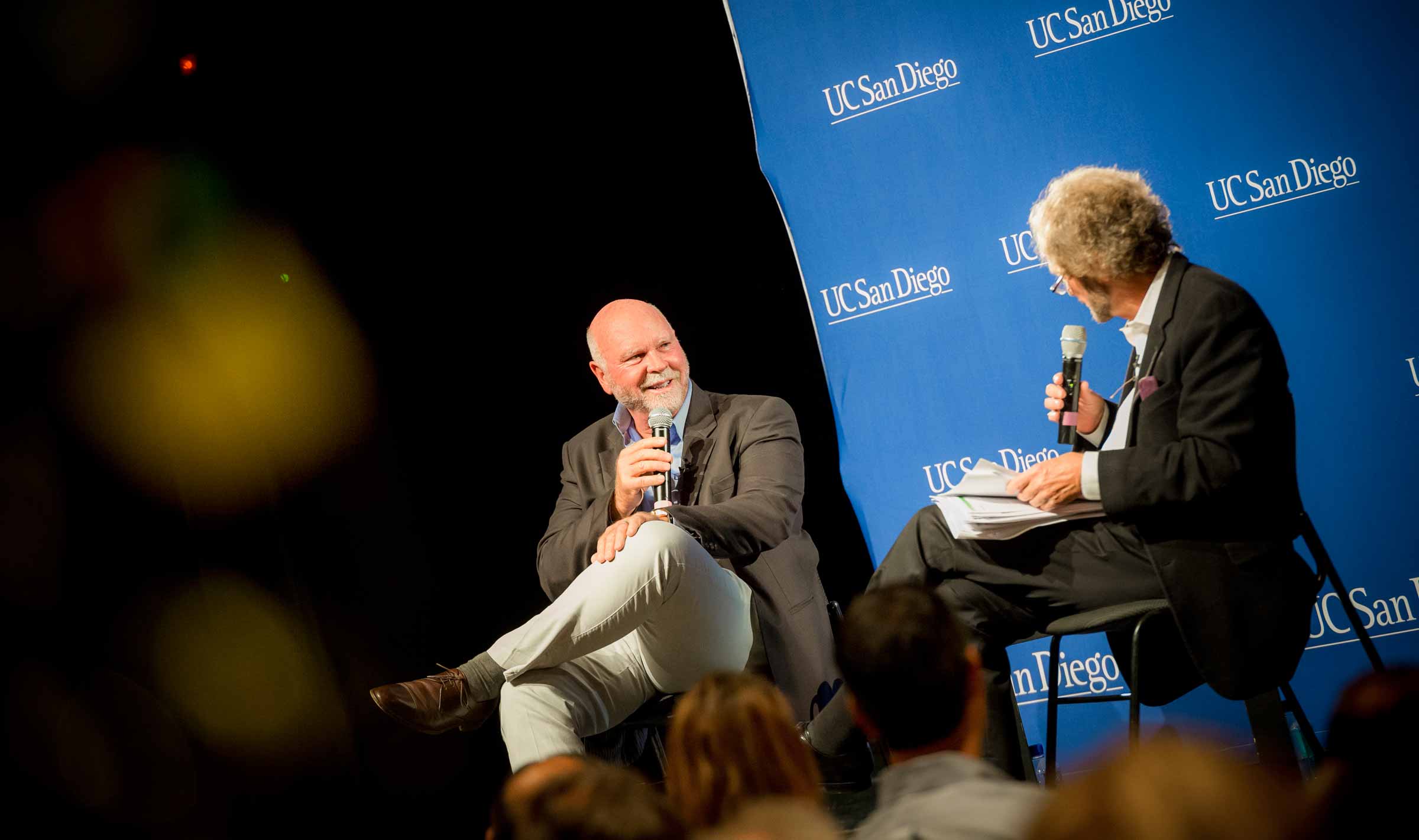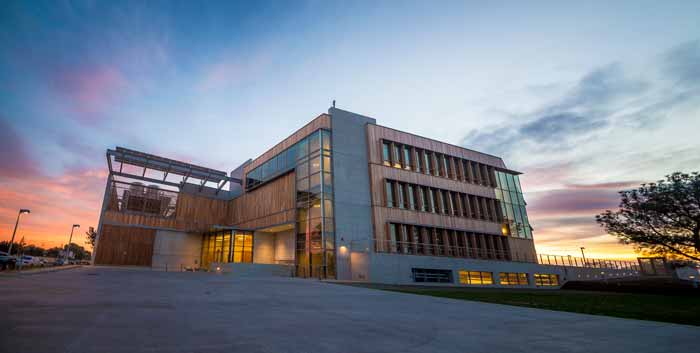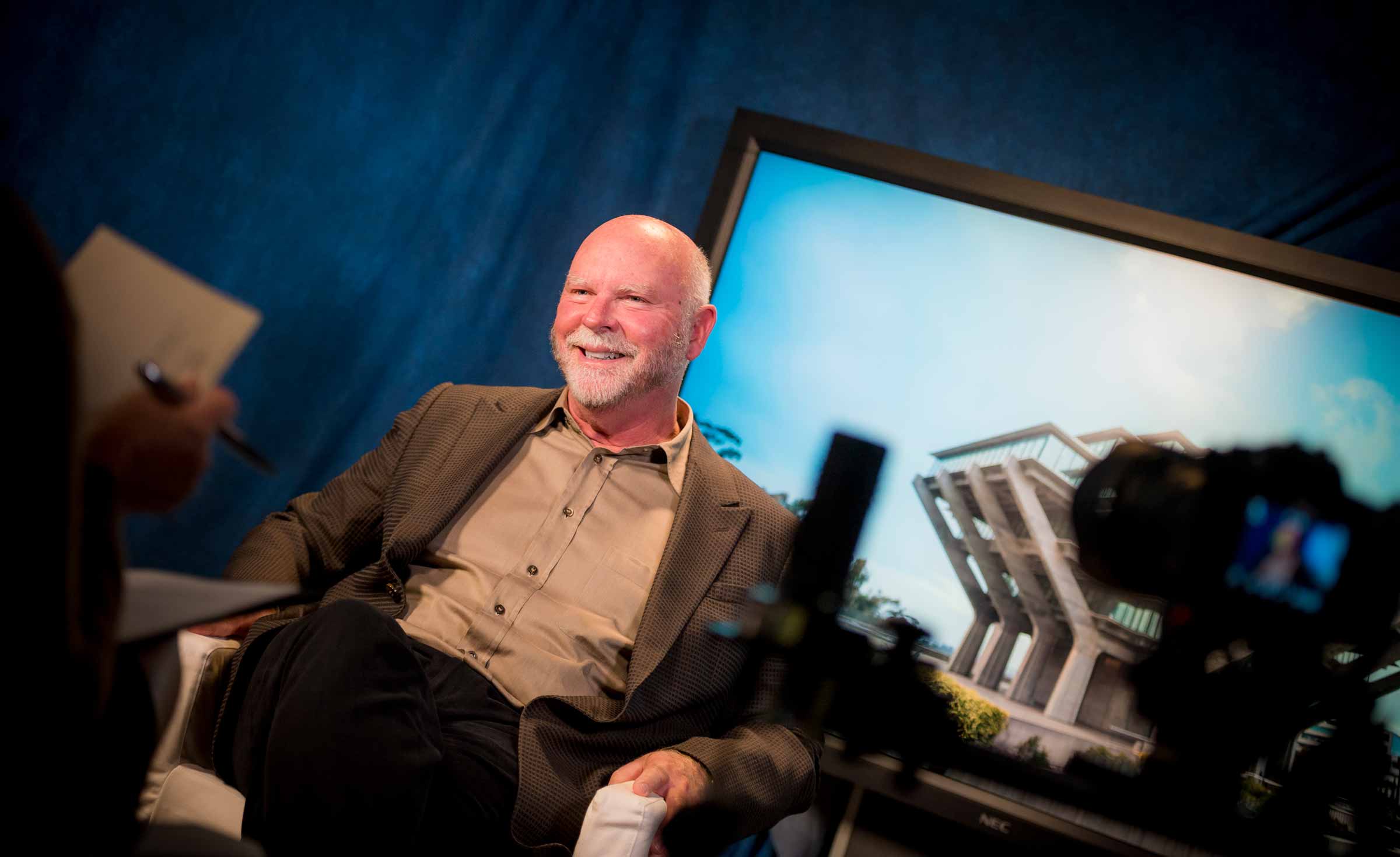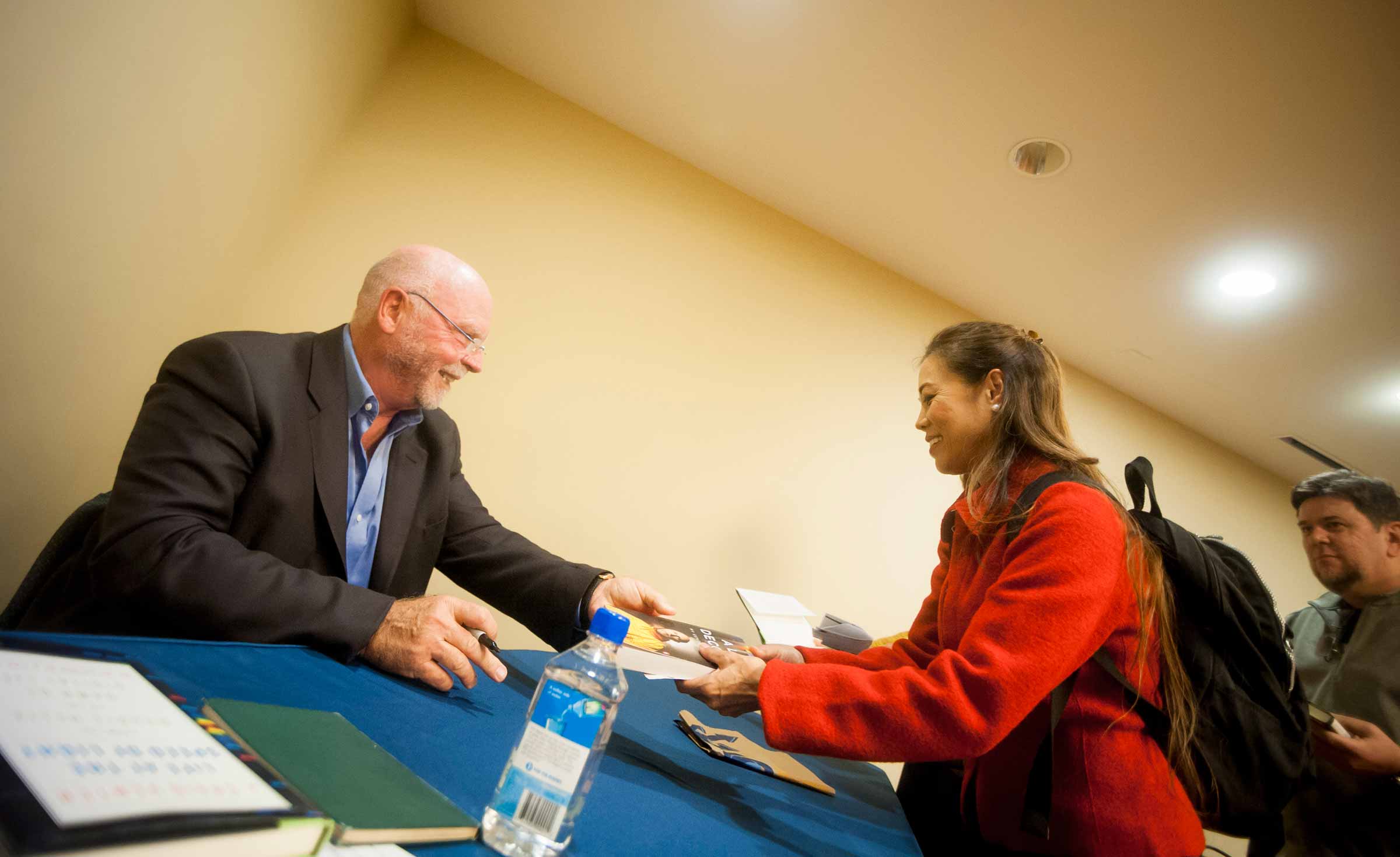Scientists Discover a New Signaling Pathway and Design a Novel Drug for Liver Fibrosis
Health & Behavior
By:
Published Date
By:
Share This:

J. Craig Venter examines the creation of life with synthetic genomics as he talks about his latest book in a recent forum at UC San Diego. Photos by Erik Jepsen/UC San Diego Publications
It only takes a few minutes of chatting with J. Craig Venter to understand what first attracted him to return to his alma mater to open a research facility here. Venter’s approach to the scientific endeavor clearly matches that of the campus that first gave him his start. Both are mavericks known for bringing out-of-the-box thinkers together from across a wide spectrum of disciplines in search of the next blockbuster scientific breakthrough.
“Universities have to evolve from their stovepipe approaches of the past to having totally multidisciplinary approaches to these complex issues in science,” said Venter. “We see the interactions here in San Diego being unique in the world and very much fitting with the philosophy of my own institute. So, I think they enhance each other.”
Venter’s scientific approach has clearly paid off over the course of his storied career. Awarded the 2008 National Medal of Science by President Barack Obama, Venter and his team sequenced the first full genome of a free-living organism, the bacterium Haemophilus influenzae, in 1995. He made worldwide headlines again in 2000 when his team tied a rival team in a furious race to be the first to sequence the human genome. Venter and his team then went on to publish the details on the construction of the first self-replicating synthetic bacterial cell in 2010. Those watershed accomplishments combined with his brash approach to scientific investigation have made him one of the powerhouses of science—and one of UC San Diego’s most well known alumni.

The new J. Craig Venter Institute research facility on the UC San Diego campus was designed to exceed requirements for LEED Platinum certification and to be carbon neutral.
“Dr. Venter is a visionary leader who is always working to push the frontiers of genomics science,” said UC San Diego Chancellor Pradeep K. Khosla. “We are pleased that our stellar alumnus has established the J. Craig Venter Institute so close to the heart of our campus, contributing to the biotech hub that encompasses UC San Diego. We look forward to our continued collaborations, as our faculty, students and researchers work to advance science and benefit our society.”
The new $37 million research facility at UC San Diego will be part of the J. Craig Venter Institute that Venter established in Rockville, Md. in 2006. The 45,000-square-foot sleek building overlooking the Pacific was designed to exceed requirements for LEED Platinum certification and to be carbon neutral. It will serve as home to about 125 scientists and staff. The institute’s researchers will focus on everything from continued sequencing and analysis of the human genome, to new research in synthetic biology and construction of a minimal genome, to continued sampling of the world’s oceans, rivers and soils to catalogue and sequence the vast unseen life living in these environments.
Perhaps one of the most futuristic projects scientists at the new center will work on is “biological teleportation.” This allows scientists to sample DNA at one location and transfer it as binary computer code over the Internet to a receiving device called a Digital Biological Converter that takes the digital code and rewrites the genetic code chemically to recreate proteins, viruses and living cells.
“Once you have the genomes built from the DNA, you can go in any direction,” Venter said. “So, we can download proteins from the Internet, such as insulin. We can make phage to kill bacteria. And we can even now, for the first time, make single, self-replicating cells.”
Venter foresees myriad applications, including being able to quickly create emergency vaccines in the face of a viral pandemic. He recalled how, in 2009, he received a crisis call from the mayor of Mexico City asking if he could digitally de-code H1N1, an influenza virus that threatened to become a world pandemic. Because of obvious health risks, the actual virus couldn’t be sent out of the country. Instead, Venter and his team successfully synthesized it in their lab by converting the digital code into synthetic DNA.
Venter predicts that Digital Biological Converters will one day become commonplace in hospitals, schools and homes. Some will even be armed with equipment capable of dispensing vials of vaccines directly to your home office.
“One day, everybody will have one of these little devices on their home computer, and we can stop pandemics before they start because in areas where there are outbreaks, you just download the vaccine and vaccinate people very quickly,” Venter said.
Venter’s team is also working with NASA scientists in the Mojave desert to develop techniques they hope will one day allow them to use biological teleportation to take samples on Mars or other distant planets, isolate the DNA and sequence it, and then send the digitized information back to Earth. There a receiving device would take the digital code and rewrite the genetic code chemically.
The story of exactly how Venter came to be engaged in such futuristic research is filled with twists and turns. And Venter is the first to admit he did not follow the traditional path to success. A self-described late bloomer who performed “dismally” in high school, Venter first made his way to southern California not to attend college—but to surf. After being “drafted off his surfboard” at age 19, he was sent to Vietnam as a Navy Corps medic. Exposed to the horror of triaging and caring for wounded soldiers, Venter fought his way out of a near-engulfing despair by deciding to dedicate himself to improving peoples’ lives in the best way he could: through scientific discovery.
Upon returning home to the U.S., he enrolled in junior college in Northern California and then transferred to UC San Diego to pursue a bachelor’s degree in biochemistry. Armed with a new perspective on life, the once dismal student had now been transformed into a seemingly unstoppable force. Recognizing Venter’s keen intellect and strong drive, faculty members at the fledging university set the young undergraduate up in his own research lab under the direction of the late Nathan Kaplan, a professor of biochemistry. Venter still vividly remembers the rush he felt upon publishing his first paper in a scientific journal. After receiving his bachelor’s degree in 1972, Venter quickly went on to pursue a Ph.D. in physiology and pharmacology at UC San Diego, which he was awarded in 1975.
Even in those early years, Venter recognized that there was something about the UC San Diego environment that matched the type of entrepreneurial scientist he dreamed of becoming.
“The campus was extremely small–mostly trees,” he said, with a chuckle. “It was not the giant campus it is today. So, it was a unique experience; the university was just getting going and the medical school was just getting going. A lot of top scientists from around the world were recruited to come and build it. And, so, the interactions with those scientists actually changed the course of my career.”
Chief among those interactions was the mentorship provided by Kaplan, whom Venter remembers as a man who “had a lot of brilliant ideas every day.” Kaplan instilled two key lessons upon the young Venter that would help him make his own mark on science: Act on your ideas and don’t be afraid of failure.
“He thought that it is the execution of ideas that makes the difference in science,” Venter said. “And I think that’s a very important notion because lots of people lay claim to ideas, but they never act on them. So, it’s pretty meaningless. The other thing he taught me was that most people are risk adverse and talk themselves out of doing the experiment. And, therefore, they think of all the reasons it might fail. So, they never do it, and, therefore, they don’t make progress in science.”
After leaving UC San Diego, Venter was appointed as a professor at the State University of New York at Buffalo and the Roswell Park Cancer Institute. But it was after moving to the National Institutes of Health (NIH) that he made his first big scientific breakthrough when, in 1991, he and his team developed a new technique to rapidly discover genes known as Expressed Sequence Tags, or ESTs.
Venter left the NIH to found The Institute for Genomic Research, or TIGR. There, in 1995, he and his team sequenced the first genome of a free-living organism, the bacterium Haemophilus influenzae, using a new method they had developed called “whole genome shotgun sequencing.”

Awarded the 2008 National Medal of Science by President Barack Obama, Venter is one of UC San Diego’s most well known alumni.
“We used a whole new approach based on breaking the genome into tiny pieces, sequencing those with automatic sequencers and then using new computer algorithms to reassemble the genome in the computer,” he said.
Venter went on to head Celera Genomics, where he would take on scientists already working on the government-funded Human Genome Project in a race to be the first to sequence the human genome. Venter’s privately funded team used their new whole genome shotgun sequencing technique to speed up the process. The two competing teams announced together in 2000 that they had both sequenced the human genome – effectively calling the race a tie.
But Venter was only getting started. In 2006, he merged several of his not for profit research institutes located in Maryland into one renamed the J. Craig Venter Institute and,a year later, published the first complete diploid human genome sequence, meaning it contained a full set of genes from both parents. The person whose genome was sequenced was in fact Venter himself.
Three years later, Venter and his team made another stunning scientific breakthrough when he announced they had developed a self-replicating synthetic cell powered by completely man-made instructions.
Venter details the meaning of that discovery in his new book, “Life at the Speed of Life: From the Double Helix to the Dawn of Digital Life.”
If J. Craig Venter has a single mantra, among so many that define his knack for discovery, it would be that human beings are essentially “DNA-driven software machines.”
As such, we are each merely a collective mass of genomic data which, when unraveled, holds the promise of answering the age-old question of “What is life?”
“The reality is the reality,” said Venter, who spoke recently at UC San Diego to discuss his latest book, "Life at the Speed of Light: From the Double Helix to the Dawn of Digital Life." "Every life form on this planet is DNA-driven software…Some of us make wonderful music, some make wonderful science. Some write books. There are many endeavors that help define humanity. I don’t feel diminished at all knowing that I’m made of DNA-driven software.” Read more
Watch the full interview in which Venter discusses his book on UCTV.
“It’s actually proof that DNA is the software of life,” he said. “The fact that we can start with the digital code in the computer and then use that code to chemically make the DNA. And that DNA software controlled everything in the cell.”
Asked of which of his two greatest achievements he is most proud—sequencing the human genome or developing a synthetic cell—Venter declines to choose.
“It is like being asked which of your children you are most proud of,” he said with a laugh. “Luckily for me, I only have one son. But I cannot choose between the two research accomplisments because they will both contribute to the future in important ways.”
While Venter’s career is marked with major scientific accomplishments, he also hit some stumbling blocks along the way, particularly in the area of securing government funding for his work. When he applied for funding to use his newly developed whole genome shotgun sequencing technique to decode the bacterium Haemophilus, for example, his grant application was denied.
“The NIH turned it down because they were sure it would not work,” Venter said. “But as soon as we published the paper on the first genome, we were able to get all the government funding in the world. So, as nice as that was, it shows how wrong the system is. Once things are known, you can get a lot of money to study them, but you can’t get money to take the risk into the unknown.”
Venter’s dealings with the scientific establishment helped transform him into an advocate for re-examining how the U.S. government funds big science, and he has often turned to private support to fund his research.
“Every breakthrough I’ve been associated with is because I had some type of independent money to just go and do the experiment,” he said. “Whereas, if we had to apply for grants to do it, we would have been stymied.”

Venter signs copies of his latest book after participating in a forum at the Price Center East on campus as part of the Helen Edison Lecture Series.
Asked if in looking back over his scientific career he thinks of himself as an outlier, Venter strongly agrees. But he said that status should serve as a warning about the state of the K-12 education system in America.
“The type of thinking and processing that I’m good at is something the education system hasn’t really known how to deal with because you can’t count it and you can’t measure it easily. But it shows up later on in life as great results. So, it seems the system is broken because for every one of me that is successful, there’s probably 99 that aren’t because they got lost in the system. They didn’t have the opportunities or the sheer luck that I had.”
At age 67, it is clear that Venter has no thought of slowing down; indeed, he already is charting endeavors that he plans to tackle over the next 20 years.
One of the chief areas he plans to concentrate on is refining techniques by which scientists can use computers to design self-replicating synthetic cells for specific uses. He hopes those processes will play a key role in helping feed and care for the globe’s ever-growing human population – a good percentage of which will otherwise struggle to survive.
“Synthetic genomics could be the new industrial revolution,” he said. “It could change the way we produce everything from food, to medicines, to fuels and clean water – even building materials for housing. And, so, if we are going to do this effectively, we need to understand how life really works.”
Share This:
Keep up with all the latest from UC San Diego. Subscribe to the newsletter today.